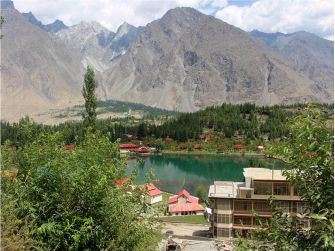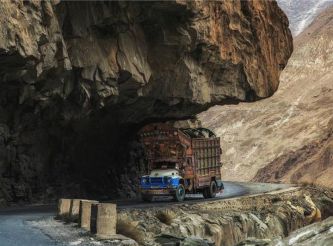Gallery:
More About Shigar Valley Pakistan:
It is an attractive valley near Skardu city, easily accessible by road. Views of mountains, fields, and a unique Baltistani culture, plus an amazing fortress turned into a boutique hotel, make this location ideal for a vacation. Shigar has a rich fruit production, such as cherries, apricots, and apples. In addition to the very special architecture of the fortress, the mosque just outside of it is a marvel to behold.
A valley named Shigar lies across the Indus River from Skardu city, northeast of the city. There is a river called Shigar that flows through Shigar Valley. Shigar River (which originates in Arandu Valley) and Braldo River (originating from Baltoro Glacier) meet in the region starting at Shigar village in the south and going up to Tisar village in the north. It takes approximately 1 hour from Skardu city to Shigar Village by road.
In the Shigar Valley, you can access the main Karakoram Range. The Shigar Valley is the only way to reach Baltoro Glacier, which ultimately leads to K2, Broad Peak, Masherbrum, Chogolisa, and other high peaks.
The Shigar Valley has numerous villages. Check the weather before visit these destinations.
Among the more significant ones are Shigar (the biggest), Namika, Alchori, Sildi, Kashmal, Yono, Hiaderabad, and Tisar. Shigar Valley’s main sources of income are agriculture and tourism. The locals are friendly and hospitable. This area does not have any security concerns.
Shigar Palace:
An Amacha Dynasty Raja of Shigar built this fort and palace in the 17th century. Additionally, it is known as Fong-Khar, which translates to Palace on the Rock. It features intricate wood carvings, stone masonry, and paintings, hallmarks of Balti architecture and art. Currently, the fort is a museum and a luxury hotel managed by Serena Hotels, which was renovated by the Aga Khan Cultural Service Pakistan.
Besides providing a glimpse into Baltistan’s history and culture, the fort affords breathtaking views of the Shigar River and surrounding mountains. It includes a museum that displays original carvings, Indigenous artifacts, and architectural history. In addition to seasonal BBQs and cherry ice cream, the fort’s historical garden offers seasonal picnics. A hotel within the fort features 20 rooms and suites decorated with antiques, handmade period furniture, and fabric from the Balti culture.
The Amburiq Mosque:
The Amburiq Mosque in Shigar Valley is a 14th-century mosque in Amburiq village. UNESCO considers it a World Heritage site and one of the oldest mosques in Baltistan. Originally built by Sayed Ali Hamdani, a famous Sufi saint who introduced Islam to the region, the mosque is dedicated to Islam. Balti architecture is applied to the mosque, which is entirely made of wood. Mosques have prayer halls divided into men’s and women’s sections.
There is a front section for men and a back section for women. Colorful frescoes decorate the walls of the mosque, depicting scenes from Islamic history and tradition. Artists from the local area are believed to have painted the frescoes with natural pigments and traditional techniques. Additionally, the mosque has a small museum that emphasizes the historical significance of the site and promotes conservation among the locals. A mosque in Shigar Valley symbolizes the Islamic heritage and spirituality of the valley.
















